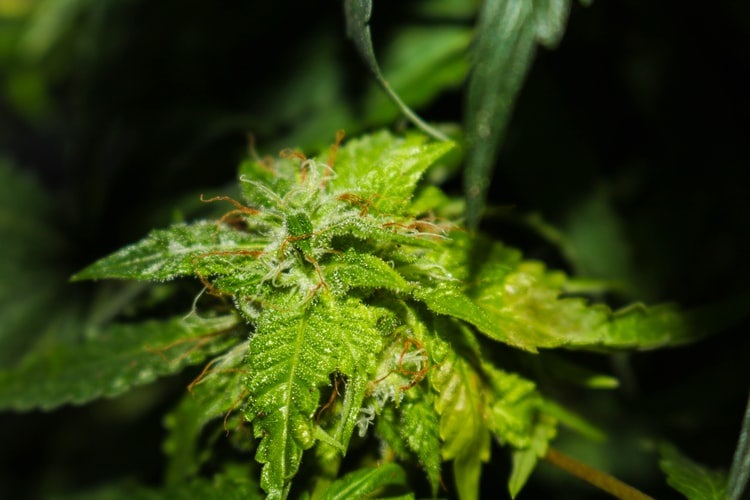How does white powdery mildew affect cannabis? Plants of all kinds are susceptible to pests and diseases, and cannabis is no exception. They can be affected by all sorts of dangerous and harmful substances, including white powdery mildew.
But worry not. If you are mindful of the disease-causing material, it is relatively simple to prevent it, including mildew infection. You will be able to treat it in the future if it strikes your cannabis.
What is White Powdery Mildew?
White Powdery mildew is a kind of fungal disease that can affect all sorts of plants. In the case of cannabis growers, they have to battle to end this particular dilemma regularly.
This disease will alarmingly leave your plants covered in a thin, white powdery material that forms on growing plants. The first sign of building up includes the curling up of leaves upward before eventually causing the plant to die completely.
The white mildew fungus will prey on this foliage, and over time, will cause the leaves to deteriorate and simultaneously impede the growth of the entire plant. White powdery mildew can lead to small crops or even to the extent of destroying the cannabis plant’s buds.
In the worst-case scenarios, white powdery mildew puts plants to death. Due to the flexible nature of the fungal spores, they can obscure their existence in your garden for a long period, targeting other plants in the future.
Causes
- Due to the imbalance of metabolism, the pathogen is more likely to attack the plant. Nutrient imbalance, along with an unsafe environment, are the main reasons why there is a lack of protection against white powdery mildew.
- Causes of deficiencies in the feeding routine might be caused by low silicon and calcium levels, which are essential in physical tissues since they play a defensive mechanism against white powdery mildew and other types of fungi. Another, it might also have abundance in nitrogen, which causes dilution to the plant sap, making it more vulnerable to pests and pathogens.
- High humidity or lack of proper airflow and ventilation environments attract different species of fungi. These fungi usually cause white powdery mildew, and it utilizes the abnormal amount of moisture to breed along with other types of fungi and diseases. Adding the lack of airflow with it, your plant does not stand a chance against these fungi.
If your garden does not have proper airflow, heat, and humidity, you will notice build-ups around your plants. These things will make the planet a habitable place for the fungal spores to multiply.
Full gardens are in the most danger of white powdery mildew infections. Your plants’ foliage that touches or overlaps one another will trap the humidity and stale air and invites the fungi to inhibit it. This will also encourage the fungi to reproduce.

How to Overcome It
- First and foremost, you have to clean up the affected areas using water with a high pH content, and you will have to use water with around 8.0-8.2 pH content. This will force the fungus out of your surface because the environment will become uninhabitable for them. It will also drive them out in the future in case they start to affect the plant again.
You have to start by securing paper towels or a clean sponge or cloth and cold water. Make sure to dispose of it properly after using it because the fungal spores tend to stick to any material it catches, and may spread to other plants in your garden.
- Pruning is also a good practice in maintaining the health of your plant. When you see any dry or yellowing leaves, get a good pair of gardening secateurs and instantly cut it off. Seeing that it is already dying, cutting this part will help your plant redirect its energy towards healthier leaves.
Once again, get rid of this pruned foliage immediately from your garden to keep the spores from spreading.
- Soils are no exception when it comes to white powdery mildew. To avoid risking the spread of fungal spores to your soil, use fresh compost to cover your plant soil’s top layer. This will help prevent splashing onto your plants when you water them in the future.
- Lastly, you have to treat your plants with an antifungal agent. Essential oils may also be your options because they are easy to use. Most fungicides only require you to mix them with water and apply them directly to plants. Also, you can use neem oil to treat your plants as well, but be sure not to get it on your buds.
Prevention
If you had this problem before, you know how hard it is to deal with it. That’s why, instead of having to deal with it again, the best action is to prevent it from happening at all.
Fortunately, if you keep an eye on the humidity levels and ensure that space in your garden has enough airflow and ventilation, mildew infection can be prevented.
By using ventilation systems and fans, you get your air moving around the space. You also have to make sure that your plants are not bunched up together and make sure that the air is moving around each one of them, especially when they are around the canopy where humid air gets trapped easily.
To control the humidity levels, you have to use a hygrometer appropriately with a figure around these numbers:
- For seedlings: 65%-80%
- For vegetative plants: 60-70%
- Maximum for flowering plants: 40%-55%
- In the final weeks before harvest: 35%-45%
Always remember that white powdery mildew is not only due to poor humidity but may be due to the extreme combination of poor ventilation, poor airflow, and hot, humid conditions. These allow the spread and formation of fungal spores.
Other Similar Molds
White Powdery mildew is only one of the many fungal pathogens out there and among the most common, but it is not the only one. The damp environment with little airflow will propagate other different fungi than can damage the plant as well.
Bud Rot
Bud rot, also known as botrytis, is another type of common fungal infection. This mold is really hard to notice on the go, but it starts to reveal itself when sugar leaves start to discolor and dry out. These signs transpire at the bottom of sugar leaves where they meet the bud.
When ignored, it will cause dead spots on flowers and produce fluffy white growths. To avoid this, keep humidity under 50% and have your fans running to provide good airflow. If you sense the breeding of bud rot, you have to remove affected buds to prevent them from spreading immediately.

Pythium
This genus of fungi includes over 150 species. Some live in the soil harmlessly while others infect plants, animals, and fungi alike. Pythium fungi cause substantial destruction to plants.
Pythium, which is also referred to as root rot, is a parasite that naturally dwells in the rhizosphere that makes them hard to detect. There are signs that can give them away, though. Signs may be present, such as foul smell, discoloration near the roots, and wilting and collapsing.
Giving your plants too much water encourages Pythium to thrive. Overwatering invites mold to form as a result of excess moisture and lack of air. The best action to prevent this from happening is to water your plant only when you notice the drying of the surface soil.
Fusarium
This type of fungal disease is particularly hard to spot and eliminate. Since fusarium specifically affects the soil, this pathogen causes root and stem rot, stunted growth, wilting, and reddening of the xylem (the one who carries water in the stem).
Fusarium causes the obstruction of xylem, which will prevent water from being distributed throughout the plant. This advances the wilting and ultimate death of the plant. Aside from being deadly, this fungus is hard to eliminate because it lurks in the soil for a long time, biding its time during hot temperatures.
If you think that you are experiencing the symptoms mentioned above, you are likely dealing with this type of dilemma. Your only course of action is to remove and destroy it as soon as possible and avoid using that particular part of your garden in the future. You have to leave the soil for at least 4 to 5 years before cultivating plants in it again, but you also have the choice to replace it with fresh earth.
Sooty Molds
Sooty molds acquired its name due to its resemblance to black substances found in fireplaces, but they can also appear as dark brown. They are a type of fungus that affects cannabis plants after being infested by pests. Following the exposure of plant sap after insect infestation, they start to infect the plant. Although their approach is indirect, their excessive growth hinders the process of photosynthesis.
At first, sooty molds appear to be harmless since early growth only warrants a thin layer of powder. However, when overlooked, it can affect plants all year round and is particularly more active during pest infestation.
It does not call for the use of chemicals because as simple as wiping or spraying the leaves with lukewarm water gets rid of the problem. If it comes back, using water will be enough to keep it away before harvest.

